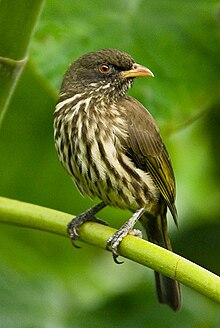Palmchat
| Palmchat | |
|---|---|

| |
| Scientific classification | |
| Domain: | Eukaryota |
| Kingdom: | Animalia |
| Phylum: | Chordata |
| Class: | Aves |
| Order: | Passeriformes |
| Superfamily: | Bombycilloidea |
| Family: | Dulidae P.L. Sclater, 1862 |
| Genus: | Dulus Vieillot, 1816 |
| Species: | D. dominicus
|
| Binomial name | |
| Dulus dominicus (Linnaeus, 1766)
| |

| |
| Synonyms | |
|
Tanagra dominica Linnaeus, 1766 | |
The palmchat (Dulus dominicus) is a small, long-tailed
The palmchat is the
Taxonomy
In 1760 the French zoologist
The palmchat is the only species placed in the genus Dulus that was introduced by the French ornithologist
Description
Palmchats are about 20 cm (8 in) in length. They are olive-brown above, and heavily streaked with brown below. Their rumps, as well as the edges of their primary feathers, are dark yellow-green. They have strong yellow bills and russet eyes. They lack the soft silky plumage of the waxwings or silky-flycatchers. Adults show no sexual dimorphism; immature birds have dark throats.[citation needed]
Distribution and habitat
The species is endemic to the island of Hispaniola (in both Haiti and the Dominican Republic), and the adjacent
Behaviour
Palmchats are very sociable birds, often seen in small flocks containing several pairs, which will roost closely together with their bodies in contact.
Breeding
The breeding season is mainly from March to June. The birds build large, messy, communal
Food
Palmchats feed on fruits and berries, including those of palms and of the gumbo-limbo tree, as well as on flowers, especially those of epiphytic orchids.[citation needed]
Voice
They are voluble and noisy birds, with a large repertoire of gurgling and cheeping sounds constantly used in their social behaviour.[citation needed] With their loud whistles, they are able to imitate the calls of hawks and kestrels which may be a surprise coming from their tiny bodies. They are typically classified as song birds, but hardly ever make a coherent song.[8]
Conservation
The palmchat is a common species within its range of about 75,000 km2 (28,958 sq mi), and highly adaptable. As it is not approaching the thresholds for the population decline criterion of the IUCN Red List (i.e., declining more than 30% in ten years or three generations), it has been evaluated as being of Least Concern.[1]
References
- ^ . Retrieved 12 November 2021.
- ^ CIA World Factbook: National Symbols
- ^ Brisson, Mathurin Jacques (1760). Ornithologie, ou, Méthode contenant la division des oiseaux en ordres, sections, genres, especes & leurs variétés (in French and Latin). Vol. 3. Paris: Jean-Baptiste Bauche. pp. 37–38, Plate 2 fig 4. The two stars (**) at the start of the section indicates that Brisson based his description on the examination of a specimen.
- ^ hdl:2246/678.
- ^ Linnaeus, Carl (1766). Systema naturae : per regna tria natura, secundum classes, ordines, genera, species, cum characteribus, differentiis, synonymis, locis (in Latin). Vol. 1, Part 1 (12th ed.). Holmiae (Stockholm): Laurentii Salvii. p. 316.
- ^ Vieillot, Louis Pierre (1816). Analyse d'une Nouvelle Ornithologie Élémentaire (in French). Paris: Deterville/self. p. 42.
- ^ a b Gill, Frank; Donsker, David, eds. (2018). "Waxwings and allies, tits, penduline tits". World Bird List Version 8.1. International Ornithologists' Union. Retrieved 16 May 2018.
- ^ Fernandez, Eladio M. (2019). "Palmchats (Dulidae)". In Grzimek, Bernhard (ed.). Grzimek's Animal Life Encyclopedia. Retrieved 28 December 2022 – via Encyclopedia.com.

